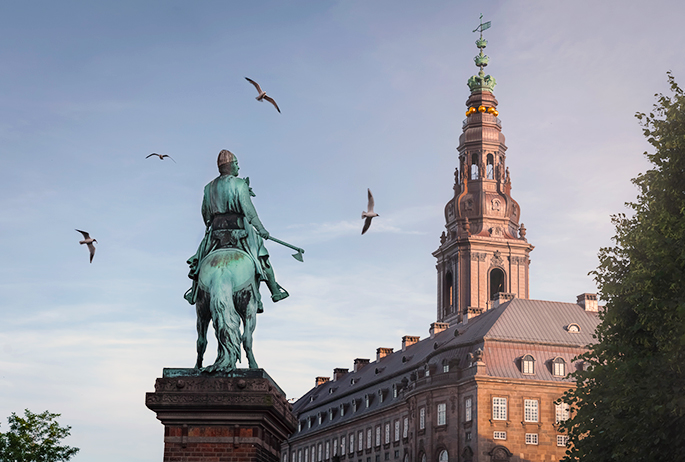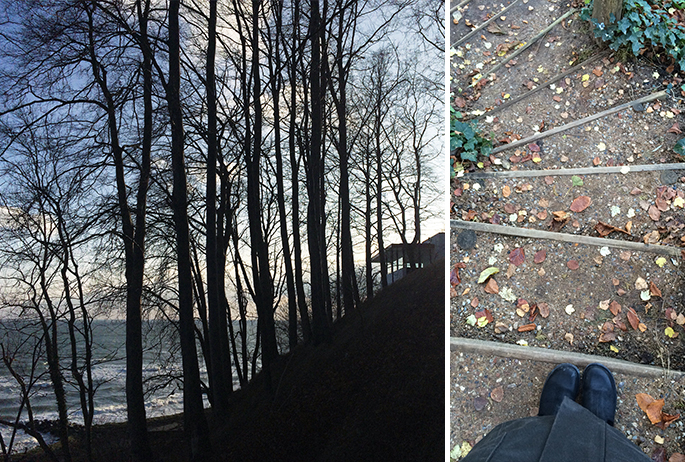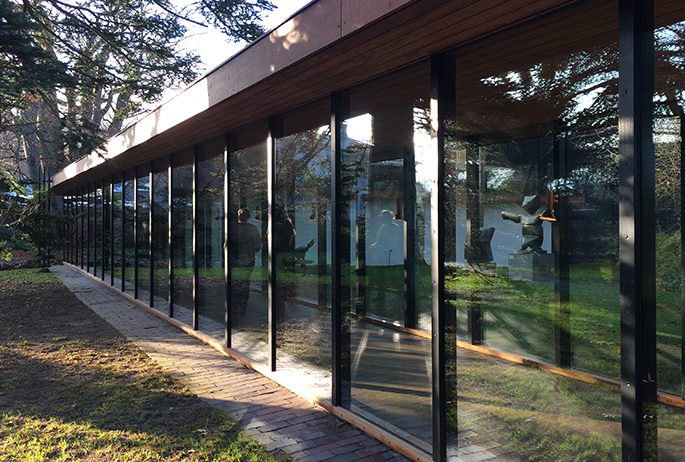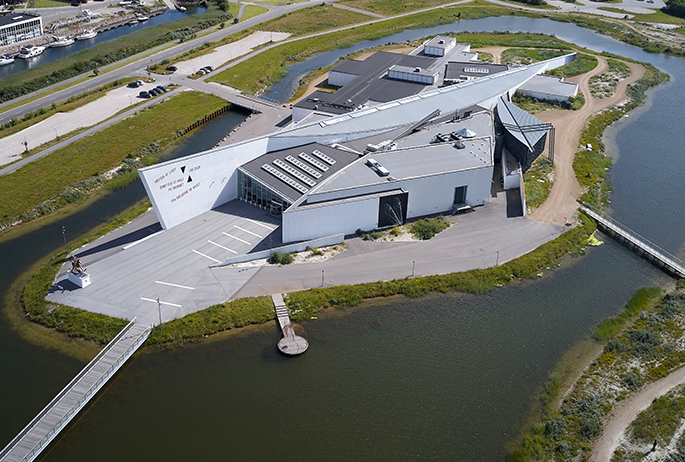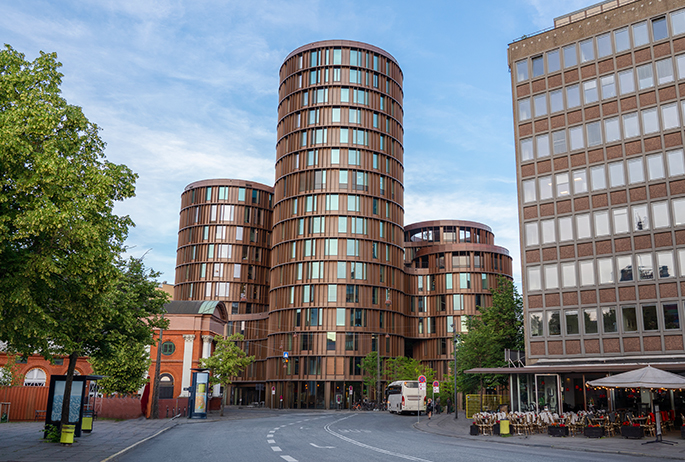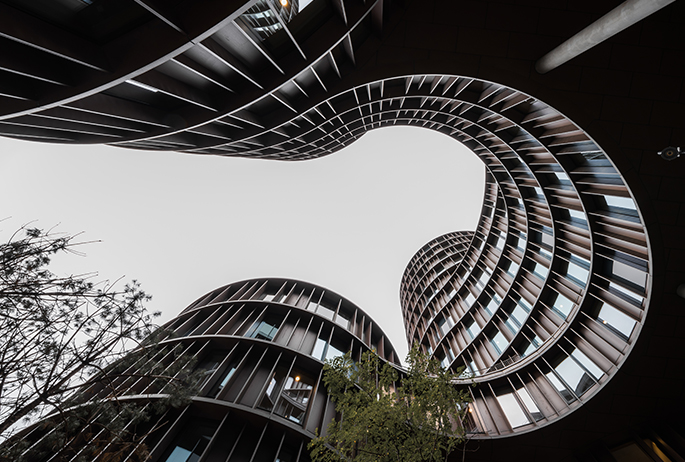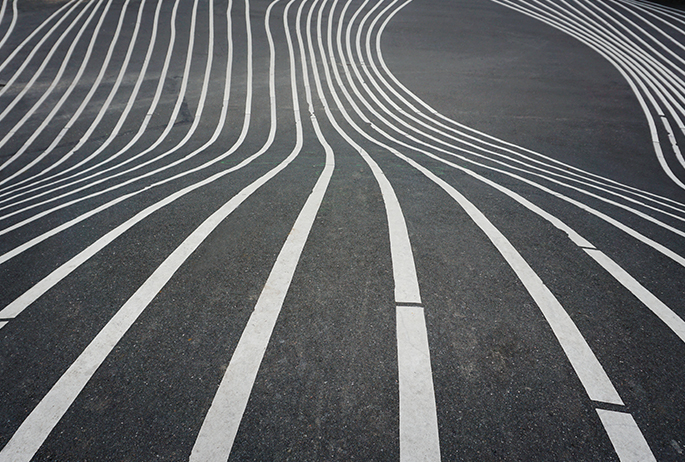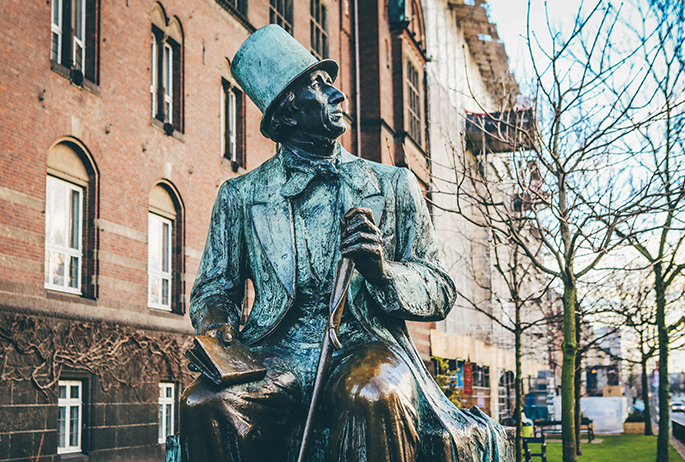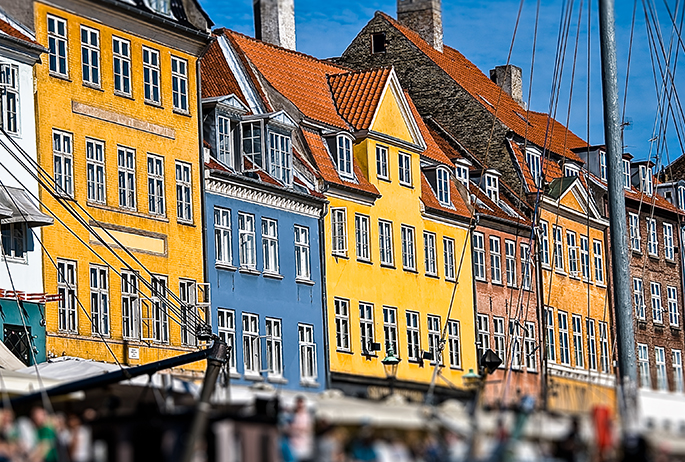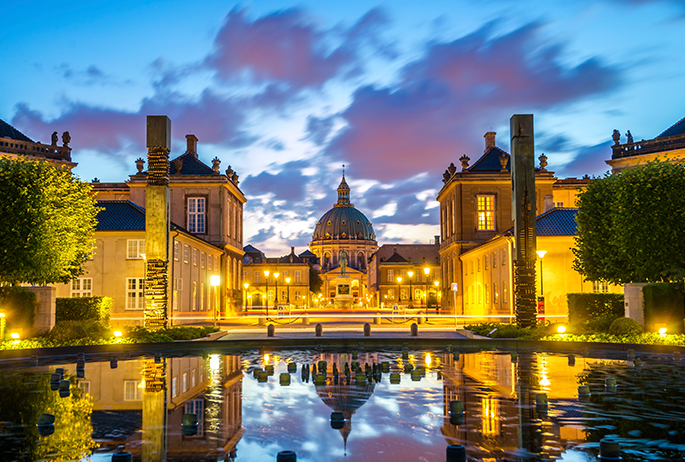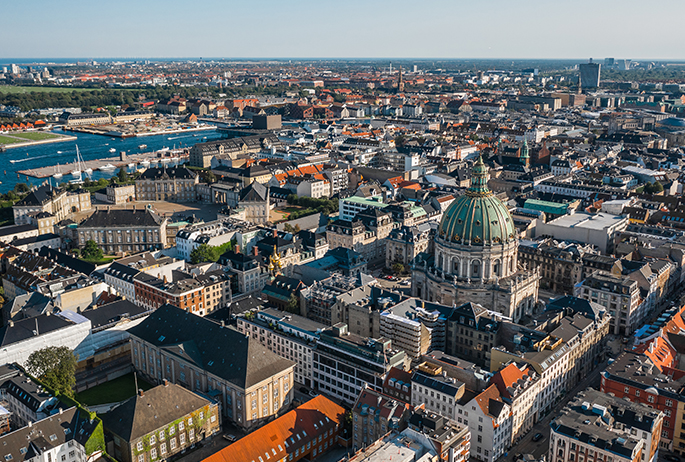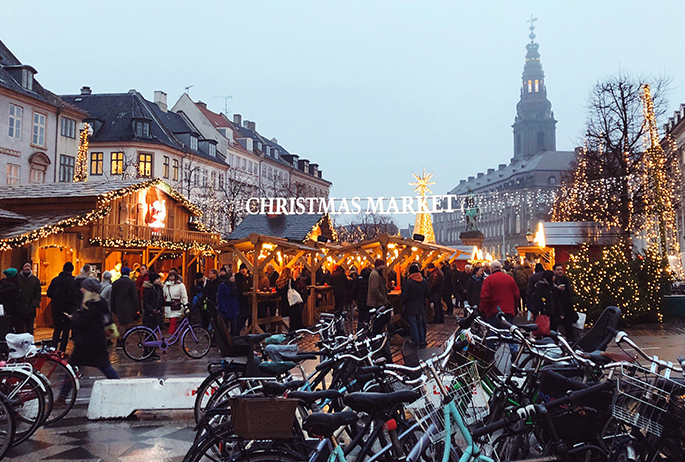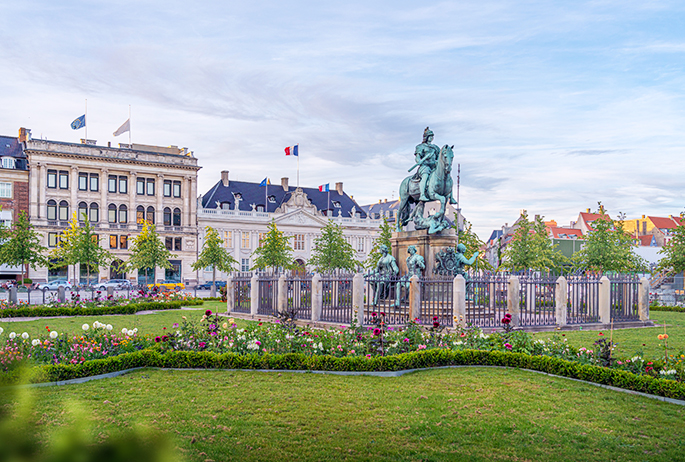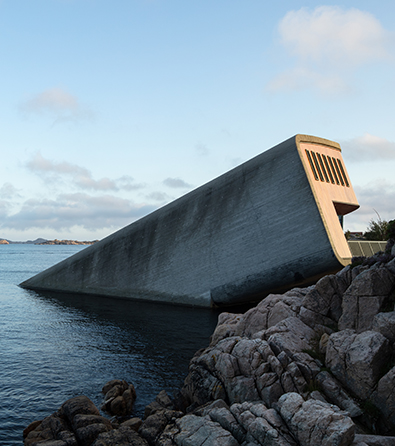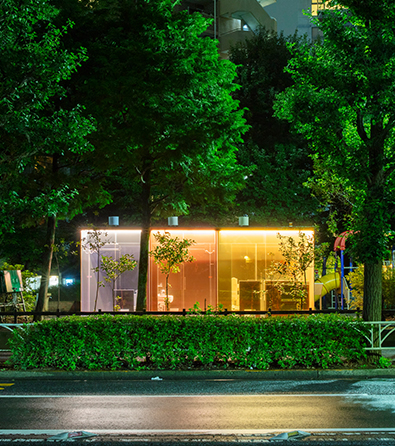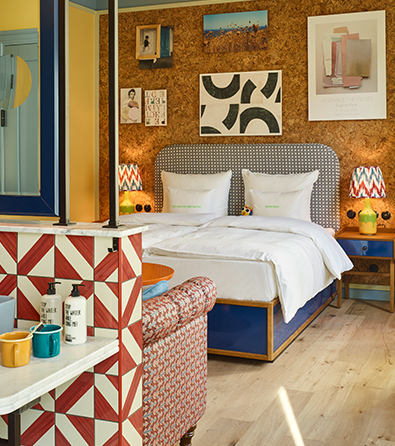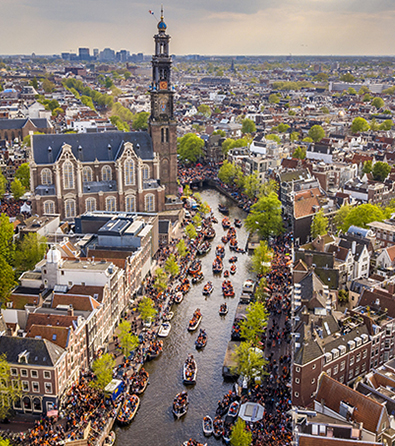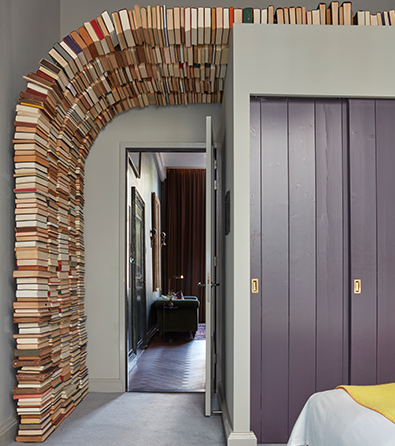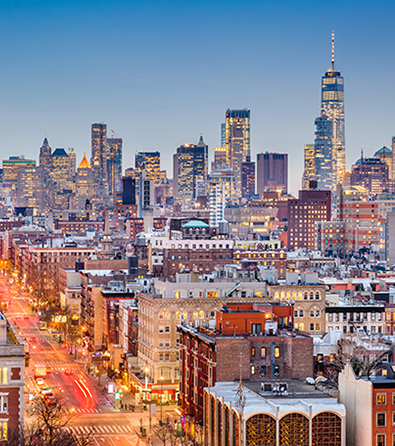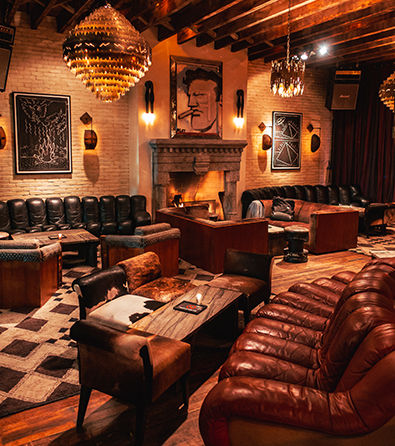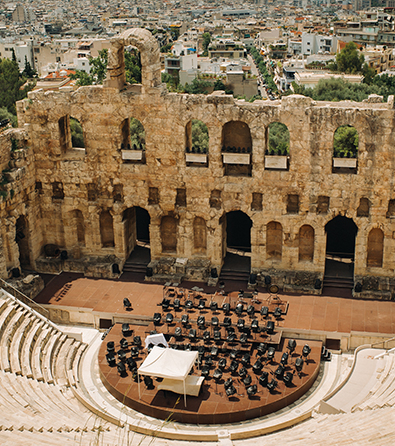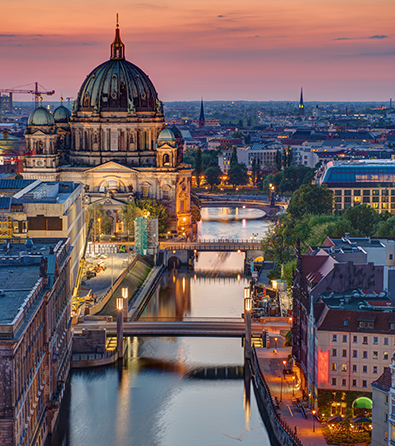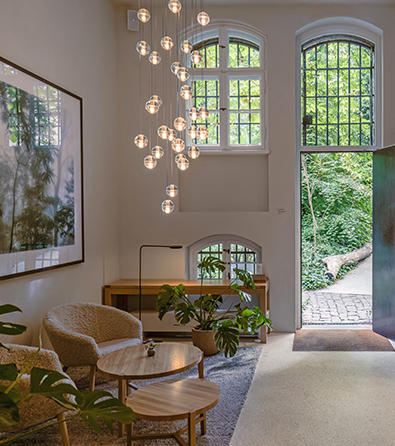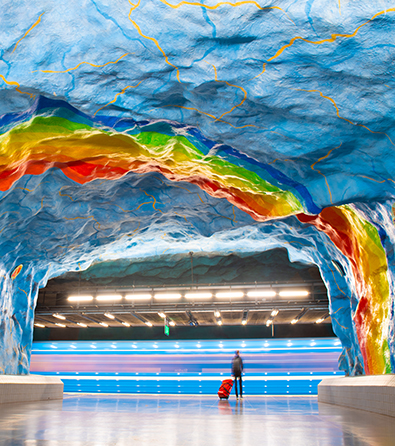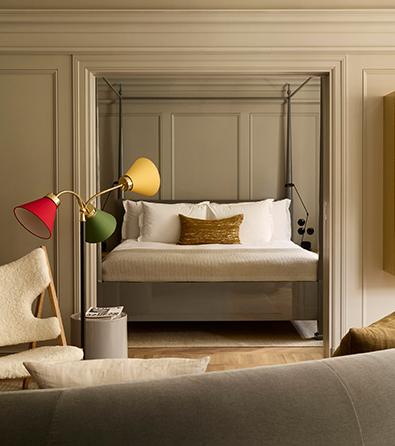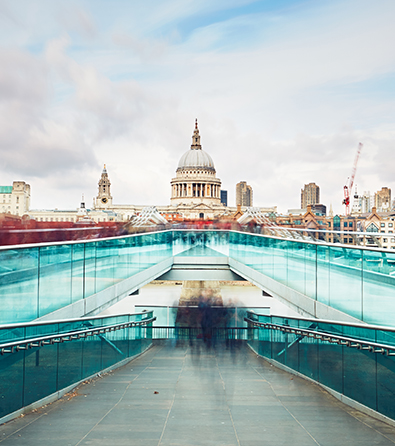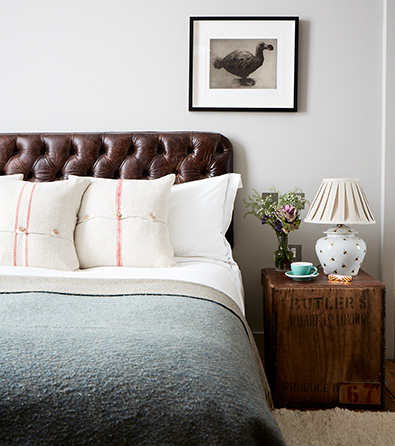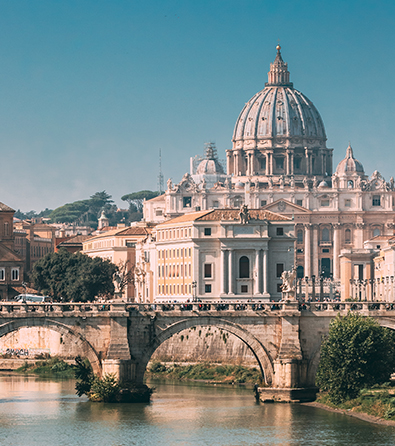Planning a trip to Copenhagen? Denmark’s cultural capital is a global hub for design and architecture lovers. In this Culture Treasures travel guide, we highlight the city’s rich design legacy and vibrant contemporary art scene. From iconic institutions like the Designmuseum Danmark and Louisiana Museum of Modern Art to hidden gems such as ARKEN, Copenhagen offers a compelling mix of heritage and innovation.
To access our exclusive Copenhagen Treasure Map, simply click the attached link and become a Culture Treasures member. The map pins every place in this guide and adds bonus cafés, boutiques and cultural venues. Planning your stay? Explore our guide to the best design hotels in Copenhagen, along with our curated urban travel essentials and long flight essentials for a comfortable journey.
Design:
Danish Design Center (BLOX / Harbourfront)
Why go: Denmark’s national hub for design innovation, exhibitions, talks, and projects on how design shapes society.
Tip: It’s inside BLOX; pair your visit with the DAC in the same complex and check DDC’s calendar before you go.
Danish Design Center (DDC) sits inside BLOX and serves as Denmark’s national center for design. Its work uses design methods to drive the country’s green, digital, and social transitions through programs developed with businesses and the public sector. Expect talks, workshops, and hands-on tools alongside occasional exhibitionsת showing how design can build capacity, rethink organizations, and improve everyday life.
Designmuseum Danmark (Frederiksstaden / Bredgade)
Why go: Denmark’s national design collection in a historic complex.
Tip: Detour to the Grønnegård courtyard and museum shop for classic Danish design gifts.
Designmuseum Danmark is Denmark’s largest museum devoted to Danish and international design, housed in the former Royal Frederik’s Hospital (1750s) in Frederiksstaden and adapted for museum use by Kaare Klint and Ivar Bentsen in the 1920s. Its collections span furniture, industrial design, decorative arts, fashion, and textiles, from the Western world and East Asia, tracing design from the late Middle Ages to today. Alongside permanent presentations (including a “Danish Modern” overview), the museum runs changing exhibitions, talks, and workshops; following a comprehensive renovation in 2020–2022, galleries and visitor areas were fully refreshed.
Normann Copenhagen (Indre By)
Why go: Brand showroom/office in the city center; check access before visiting.
Tip: If the showroom isn’t open, explore the collection online and nearby design boutiques on the same streets
Normann Copenhagen is a Danish design brand known for bold contemporary furniture, lighting, and accessories. In Copenhagen, its showroom is in Indre By (Niels Hemmingsens Gade) and open by appointment; during the city’s June design festival, it typically opens to the public for special exhibitions. Inside, the collection is staged in evolving, home-like settings that spotlight materials, finishes, and new launches.
ETAGE Projects (Indre By / Borgergade)
Why go: Boundary-pushing gallery for experimental “collectible design” where art and design meet.
Tip: Hours are limited (Tue-Sat); confirm the current exhibition and combine with nearby Bredgade/Designmuseum stops.
ETAGE Projects is a Copenhagen art-and-design gallery on Borgergade that champions experimental, “collectible” work at the intersection of art and design. Led by Maria Foerlev, the program deliberately blurs boundaries, abstraction and function, object and artwork, through tightly curated exhibitions, commissions, and editions with international creators. Shows rotate regularly and emphasize material exploration and concept-driven practice; the gallery maintains regular public hours at its central Indre By space.
HAY House (Indre By / Strøget)
Why go: Flagship showcase of contemporary Danish interiors overlooking Copenhagen’s main pedestrian street.
Tip: Visit late afternoon for soft light over Amagertorv from the second floor.
HAY House is HAY’s flagship in central Copenhagen, set on the second floor of a historic building on Østergade (Strøget). The light-filled rooms present furniture, lighting, textiles, and accessories in apartment-style settings with views over Amagertorv. After a 2021 revamp, the original two-storey boutique was complemented by additional showroom floors for displays and events. The store is open seven days a week.
Muuto HQ & Space (Indre By / Østergade)
Why go: Muuto’s 1,400 m² headquarters and showroom, an immersive take on contemporary Scandinavian design.
Tip: Visits are by appointment only; email ahead. It’s just off Strøget, so you can pair it with central-city design shopping.
Muuto HQ & Space is the brand’s 1,400 m² headquarters and appointment-only showroom in central Copenhagen, located on Østergade. Redesigned by Danielsen Spaceplanning with BRIQ, the three-floor space deliberately blurs workplace and showroom: collaborative zones, meeting rooms, and quiet work areas sit alongside home-like product displays that show Muuto’s furniture, lighting, and accessories in use. During the city’s June design festival, the HQ typically opens to the public for special programming.
Stilleben Flagship (Indre By / Nørreport)
Why go: Curated ceramics, glass, and textiles by Copenhagen designers.
Tip: Combine with Torvehallerne food halls two minutes away.
Stilleben is a Copenhagen design shop and brand founded in 2002 by designers Ditte Reckweg and Jelena Schou Nordentoft. Its flagship on Frederiksborggade (by Nørreport) presents a tightly curated mix of Danish and international craft, ceramics, glass, textiles, jewelry, and prints, alongside Stilleben’s own tableware and home collections. The selection emphasizes craftsmanship, honest materials, and durable, contemporary design, with rotating displays and limited editions keeping the assortment fresh.
Designer Zoo (Vesterbro)
Why go: Live craft workshops plus a rotating selection of Danish design across disciplines.
Tip: Time your visit when makers are “in studio” to watch them at work.
Designer Zoo is a Copenhagen design-and-craft hub that combines a large shop with open workshops where visitors can watch makers at work. Founded and run by designer Karsten Lauritsen, it opened in 1999 and today represents around 75 Danish artisans across ceramics, glass, jewelry, textiles, and furniture. Spread over two floors, the space also houses the workshop for Lauritsen’s customizable Bønnebord (“Bean Table”), alongside an evolving selection of locally made pieces.
3daysofdesign (June, annually)
3daysofdesign is Denmark’s annual, and largest, design festival, staged across Copenhagen each June from Wednesday to Friday. Showrooms, galleries, and public spaces host hundreds of exhibitions, talks, workshops, and product launches. The festival is open to everyone and free to attend, drawing industry professionals and design-curious visitors from around the world while spotlighting new concepts alongside modern classics and experimental work.
Architecture:
Danish Architecture Center – DAC @ BLOX (Harbourfront)
Why go: Start with the giant aerial “City Map” floor to plan your architecture walk.
Tip: Grab coffee on the waterfront and explore current exhibitions inside BLOX.
Danish Architecture Center (DAC) is Denmark’s national hub for architecture, housed in OMA’s BLOX on the inner harbor. Inside, the permanent exhibition So Danish! traces Danish architecture from the Viking Age to today, while rotating shows explore contemporary city-making, innovation, and sustainability. Beyond the galleries, DAC runs year-round guided city walks and workshops for all ages. Finish at the top-floor DAC Café, where panoramic windows and three rooftop terraces look out over the harbor and the city’s spires.
VM Houses (Ørestad)
Why go: Iconic “V” and “M” residential blocks by BIG/JDS that helped define modern Ørestad.
Tip: Photograph the façades from Ørestads Boulevard; respect residents’ privacy.
Two adjoining residential blocks shaped like a “V” and an “M,” VM Houses were designed by PLOT (Bjarke Ingels and Julien De Smedt) and completed in 2004–2005. The plan opens each slab to secure diagonal views over Ørestad, maximizing daylight and privacy while minimizing face-to-face exposure. The V-building is distinguished by shard-like triangular balconies along its south façade; the M-building breaks the diagonal logic into interlocking “fingers.” Inside, layouts are highly varied, 114 apartments in V and 95 in M, with many double-height spaces and broad south-facing glazing.
Axel Towers (City / Tivoli area)
Why go: Five rounded copper-clad towers by Lundgaard & Tranberg on Axeltorv.
Tip: Pair with Tivoli or Vesterbrogade, everything is across the street.
Axel Towers is a mixed-use ensemble of five circular towers by Lundgaard & Tranberg Architects on Axeltorv, opposite Tivoli Gardens. Completed in 2017, the buildings rise from 5 to 15 stories, with the tallest reaching about 61 m. The façades are clad in tombac, a copper and zinc alloy that gradually patinates, and the complex combines offices with ground-floor retail and an elevated public square with planting. The top levels house Restaurant TRIO, which offers panoramic views over the city.
8 House / 8Tallet (Ørestad South)
Why go: Bjarke Ingels’s figure-8 mixed-use complex with rooftop paths and views over Kalvebod Fælled.
Tip: Best perspective from the parkland edges around Richard Mortensens Vej.
Completed in 2010 by BIG, 8 House is a 61,000 m² mixed-use complex shaped as a figure eight that wraps two courtyards and faces the open meadows of Kalvebod Fælled. A continuous sloping promenade lets you walk or bike from street level to upper floors, threading past terraced gardens and varied housing typologies. The project combines about 476 homes, apartments, townhouses, and penthouses, with roughly 10,000 m² of offices and retail at the base, arranged to maximize daylight, views, and privacy.
The Round Tower / Rundetaarn (Indre By)
Why go: 17th-century spiral ramp leading to a 360° city view and a historic observatory.
Tip: Go right at opening for minimal crowds and clear rooftop vistas.
Round Tower is a 17th-century observatory built under King Christian IV, forming part of the Trinitatis Complex with Trinitatis Church and the former University Library. Its signature spiral ramp winds 7½ turns to a viewing platform 34.8 m above street level, wide enough to haul instruments (and famously ridden by Tsar Peter the Great in 1716). Today, visitors walk the ramp for panoramic city views, and the adjoining Library Hall (above the church) hosts exhibitions and events.
Contemporary Art Centers and Museums:
SMK – National Gallery of Denmark (Østre Anlæg / Inner City)
Why go: Denmark’s largest art museum—old masters to contemporary program.
Tip: Combine with a stroll in Østre Anlæg park next door.
SMK is Denmark’s largest art museum, presenting Danish and international art from the 14th century to today. Permanent displays span the Danish Golden Age, a renowned collection of French modernism, and contemporary art, with highlights by Rubens, Matisse, Hammershøi, Munch, and Mantegna. Architecturally, a 19th-century Italian Renaissance–style building is linked to a 1998 extension by C.F. Møller via the glass-roofed “Sculpture Street,” which opens toward Østre Anlæg park.
Louisiana Museum of Modern Art (Humlebæk, North Zealand)
Why go: Landmark museum where art, architecture, and sea views meet; an easy train day trip.
Tip: Take the coastal train to Humlebæk; it’s a short walk from the station.
Louisiana Museum of Modern Art is set on the Øresund coast in Humlebæk, north of Copenhagen. Designed and expanded by Jørgen Bo and Vilhelm Wohlert, its low pavilions and glass corridors link galleries to a sculpture park and sweeping sea views. The collection focuses on post-1945 international art, with a dedicated Giacometti gallery, and hosts major temporary exhibitions year-round. The seamless blend of art, architecture, and landscape makes Louisiana one of Scandinavia’s most visited modern and contemporary art museums.
ARKEN Museum of Contemporary Art (Ishøj, south of CPH)
Why go: Beach-side contemporary art museum with bold, family-friendly shows.
Tip: Check ARKEN’s site for current installations before you head out.
ARKEN Museum of Contemporary Art sits on the shore of Køge Bay in Ishøj, south of Copenhagen, and is celebrated for its deconstructivist, maritime-inspired architecture by Søren Robert Lund—often likened to a stranded ship, with a 150-metre “Art Axis” as its hull. Opened in 1996, ARKEN presents Danish and international contemporary art through changing exhibitions and a collection of about 400 works, including pieces by Olafur Eliasson, Ai Weiwei, Grayson Perry, and Damien Hirst. The museum’s coastal setting is part of the artificial Køge Bay Beach Park and includes a sculpture park; inside, the lifeboat-shaped café overlooks the water.
The Hirschsprung Collection (Østre Anlæg / Østerbro edge)
Why go: Danish Golden Age masterpieces in an intimate villa beside SMK.
Tip: Look for Hammershøi and Skagen painters; the museum is compact, perfect for 60–90 minutes.
The Hirschsprung Collection is a treasure trove for anyone interested in Danish art. This unique museum offers an intimate encounter with Danish art from the 19th and early 20th centuries. The collection, assembled by tobacco manufacturer and art collector Heinrich Hirschsprung, was donated to the Danish state in 1902 and officially opened to the public in 1911. The museum houses significant works by prominent artists such as P.S. Krøyer, C.W. Eckersberg, and Christen Købke, among others. The Hirschsprung Collection is located in a charming neoclassical building in the green parklands of Østre Anlæg, in the heart of Copenhagen. In addition to its permanent displays, the museum hosts temporary exhibitions, children’s activities, and guided tours.
Nikolaj Kunsthal (Indre By)
Why go: Contemporary art inside a former church with an atmospheric tower.
Tip: Check for evening events/exhibitions; location is steps from Strøget.
Nikolaj Kunsthal is a unique contemporary art center situated in a former church in the heart of Copenhagen. Originally constructed in the 13th century and known as St. Nikolaj Church, it is one of the oldest churches in the city. The church was repurposed into an art gallery after the great fire of 1795 and now serves as a premier exhibition space for contemporary art. Each year, Nikolaj Kunsthal hosts 7-9 exhibitions featuring both national and international artists, with a strong focus on experimental and innovative art. The center is known for its breathtaking panoramic views of Copenhagen, which can be enjoyed from its tower. In addition to exhibitions, the space is utilized for various cultural events such as concerts, performances, and lectures, making it a dynamic cultural hub in the city.
Ordrupgaard (Charlottenlund / Gentofte)
Why go: A standout mix of French Impressionism and Danish Golden Age art in a serene park setting, plus striking extensions by Zaha Hadid and Snøhetta, and Finn Juhl’s House on the grounds.
Tip: Finn Juhl’s House often requires timed entry, reserve ahead. From central Copenhagen, take an S-train north and continue by a short bus or bike ride.
Ordrupgaard is a neoclassical country house–turned museum in Charlottenlund, built in 1916–1918 for collectors Wilhelm and Henny Hansen by architect Gotfred Tvede. Its collection focuses on 19th- and early-20th-century Danish and French art, pairing Impressionists such as Monet, Renoir, and Degas with Danish masters including Vilhelm Hammershøi. In 2005, Zaha Hadid added a flowing black-concrete wing, and in 2021 Snøhetta completed five largely subterranean galleries that extend the museum beneath the park and connect seamlessly to the existing route. The grounds include gardens by Valdemar Fabricius Hansen, an English-style landscape with a formal rose garden, and Finn Juhl’s House (1942), the designer’s original home and interior, open to visitors on selected days.
Copenhagen Contemporary (Refshaleøen / Harbourfront)
Why go: Immersive, large-scale contemporary art in vast industrial halls at the former shipyard on Refshaleøen.
Tip: Pair your visit with the nearby waterfront food market; arrive earlier on weekends and consider the harbor bus or a bike ride for a scenic approach.
Copenhagen Contemporary, located on the island of Refshaleøen in Copenhagen, is an international center for contemporary art. Housed in the impressive former welding hall of the Burmeister & Wain shipyard, the space spans 7,000 square meters and has been redesigned by architect Dorthe Mandrup. This vast industrial setting is perfect for large-scale art installations, performance art, and monumental video works. Copenhagen Contemporary features works from renowned international artists, fostering a dynamic dialogue between the artworks and visitors. The center also offers a variety of programs, including artist talks, performances, concerts, and educational workshops, enriching the visitor experience and providing a comprehensive cultural encounter. Refshaleøen, the district where Copenhagen Contemporary is situated, is known for its industrial history and has transformed into a vibrant cultural hub.
Kunsthal Charlottenborg (Nyhavn / Kongens Nytorv)
Why go: One of Northern Europe’s largest contemporary-art spaces set in the Baroque Charlottenborg Palace, with an international program.
Tip: Enter via the palace courtyard and pair with a Nyhavn stroll; the Kongens Nytorv metro stop is a short walk.
Kunsthal Charlottenborg in Copenhagen is an unmissable destination for contemporary art enthusiasts. Housed in the magnificent Charlottenborg Palace, this institution is one of the largest and most beautiful spaces for contemporary art in Northern Europe. It plays a vital role in the Danish art scene, featuring a vibrant mix of exhibitions from groundbreaking international and local artists. Kunsthal Charlottenborg is also the official venue for the annual Charlottenborg Spring Exhibition, one of the oldest and most progressive visual arts exhibitions in the world. Combining its historic architectural charm with a bold and innovative art program, Kunsthal Charlottenborg offers a unique and enriching cultural experience.
Art Galleries:
Gammel Strand (formerly Kunstforeningen GL STRAND) presents Danish and international contemporary art with 6–8 exhibitions a year; Galleri Nicolai Wallner (founded 1993) is known for ambitious, innovative contemporary programs with long-term artist collaborations; V1 Gallery (founded 2002) helped shape Copenhagen’s contemporary scene and now operates three spaces in the Meatpacking District; Nils Stærk (founded 1997) is a Copenhagen gallery with an international profile across conceptual and contemporary practices; Martin Asbæk Gallery (founded 2005) shows international contemporary art and is particularly recognized for photo-based work.
Shopping Delight:
Designmuseum Danmark Shop offers a hand-picked selection tied to exhibitions, design classics, books, and contemporary Danish/Scandinavian brands; Dansk Møbelkunst Gallery specializes in rare, original Nordic furniture from the 1920–1970 cabinetmaking era; Time’s Up Vintage curates archival designer fashion and accessories; KLASSIK is a leading dealer in pre-owned Danish design, furniture, lighting, ceramics, expertly authenticated and restored; The Apartment (Christianshavn) presents a constantly re-curated, lived-in showroom mixing vintage finds with contemporary design so you can “shop the home.”
And Beyond:
Cisternerne (Frederiksberg / Søndermarken)
Why go: Subterranean art space in 19th-century water cisterns beneath Søndermarken, hosting immersive site-specific installations.
Tip: It’s cool and near-100% humidity year-round, bring layers and flat shoes; pair with a stroll in Søndermarken/Frederiksberg Gardens.
Cisternerne is nestled in the city’s Frederiksberg district, this former water reservoir has been transformed into a striking subterranean venue for contemporary art. The naturally occurring stalactites and stalagmites, combined with the eerie echoes of dripping water, create an otherworldly atmosphere, only enhanced by the frequently changing exhibitions of light and art installations. Cisternerne is a place to experience art in a unique, immersive setting, providing a sensory experience that goes beyond the visual.
Reffen – Copenhagen Street Food (Refshaleøen / Harbourfront)
Why go: Open-air street-food market and cultural space on the Refshaleøen waterfront—Northern Europe’s largest, with dozens of stalls, bars, and seasonal events.
Tip: Come by harbor bus or bike; expect crowds on sunny weekends. It’s mostly outdoors with some covered areas, so dress for the weather; entry is free and family-friendly.
Reffen is an outdoor street food market and cultural space located on the island of Refshaleøen in Copenhagen. The market hosts over 50 food stalls representing global cuisines, including dishes from Nepal, Cambodia, Jamaica, and Central Africa. Besides food, Reffen also features bars, creative workshops, and various cultural events, such as live music and festivals. Reffen emphasizes sustainability and creativity, with a focus on reducing and reusing waste. Most of the stalls are made from recycled materials, including old shipping containers. The market is a hotspot for start-ups, innovation, and community engagement, creating a vibrant and eco-friendly atmosphere for both locals and tourists.
Jægersborggade (Nørrebro)
Why go: Once gritty, now a vibrant strip with around 40 indie galleries, craft studios, cafés, and boutiques.
Tip: Do a tasting loop Coffee Collective, Meyers Bageri, and Istidת then a glass at Terroiristen and caramels from Karamelleriet; weekends get busy, go earlier.
Jægersborggade in the Nørrebro district has evolved from a run-down street into one of Copenhagen’s most vibrant destinations. Today it’s home to around forty small galleries, artisan workshops, organic cafés, and independent boutiques. Highlights include The Coffee Collective, a specialty roastery and café co-founded by World Barista Champion Klaus Thomsen; Meyers Bageri for fresh pastries; Terroiristen, an underground wine bar focused on traditional, terroir-driven wines; Istid, an organic ice-cream shop using liquid nitrogen; Ro Chokolade for hand-crafted chocolates; and Karamelleriet for artisan caramels. Note: Relæ, the Michelin-starred restaurant that helped spark the street’s revival, has closed.
Superkilen (Nørrebro / Mimersgade Quarter)
Why go: Award-winning linear urban park by BIG, Topotek 1, and SUPERFLEX, divided into three color-coded zones with everyday objects gathered from around the world.
Tip: Come early or near sunset for photos; kids love the hills and playgrounds in the Green Park. Easiest access via the M3 metro (Nørrebros Runddel or Skjolds Plads), then a short walk.
Superkilen is an award-winning urban space in the Nørrebro district, created by BIG, Topotek 1, and SUPERFLEX. Stretching roughly 750 meters and covering about 30,000 m², it’s arranged as three distinct zones, the Red Square, the Black Market, and the Green Park, each with a different look and use. Across the park are more than 50 everyday objects and artworks sourced from countries around the world, chosen with input from local residents to reflect the area’s diversity. The Red Square focuses on modern urban life with sport and cultural activities; the Black Market acts as an “urban living room” with seating and a fountain; and the Green Park offers lawns, hills, playgrounds, and sports areas. Superkilen has received international recognition, including the 2016 Aga Khan Award for Architecture and a 2013 AIA Honor Award.
Nyhavn (Indre By / Kongens Nytorv)
Why go: Colorful 17th-century waterfront of bright townhouses and historic wooden ships; the classic postcard view of Copenhagen.
Tip: Come early or at golden hour; many canal tours depart from the quayside. In winter, the harborside hosts a small Christmas market.
Nyhavn is one of Copenhagen’s most iconic waterfronts, laid out in the late 17th century as a commercial harbor linking the city to the sea. The canal is lined with brightly painted townhouses, some from the 1600s, and a row of wooden ships that recall its maritime past. Today the quays are filled with cafés, bars, and restaurants serving Danish staples like smørrebrød; live music is common in warmer months, and in winter the area hosts a Christmas market. Nyhavn is also a main departure point for canal tours. Hans Christian Andersen lived at several addresses along the canal, including Nos. 20, 67, and 18, and wrote some of his early fairy tales here.
Hans Christian Andersen – Statues & Sites (City Hall Square / King’s Garden / Langelinie)
Why go: Follow Andersen’s legacy via two bronze statues and the iconic Little Mermaid.
Tip: Walk between City Hall Square and the King’s Garden, then bike or take the harbor bus to Langelinie; arrive early at the Mermaid to avoid crowds.
Hans Christian Andersen (born 1805 in Odense) later made Copenhagen his home, and the city honors him with several monuments. In City Hall Square stands a seated bronze statue by Henry Luckow-Nielsen from 1965; another, by August Saabye from 1880, is set in the King’s Garden. On the Langelinie promenade, the Little Mermaid, Edvard Eriksen’s bronze unveiled in 1913 and inspired by Andersen’s tale, perches on a rock by the water. Modest in scale, it remains one of Denmark’s most visited landmarks.
Six Forgotten Giants (Western Suburbs / Vestegnen)
Why go: A treasure-hunt trail of six oversized wooden sculptures by Thomas Dambo, built from recycled scrap wood and tucked into parks and lakesides west of Copenhagen.
Tip: Plan a loop by bike or car and bring the artist’s clue map; some paths are unpaved, wear sturdy shoes.
The Six Forgotten Giants are large wooden sculptures in the western suburbs of Copenhagen, created in 2016 by artist Thomas Dambo from recycled materials and discarded pallets with help from local volunteers. Scattered across Rødovre, Hvidovre, Vallensbæk, Ishøj, Albertslund, and Høje Taastrup, they invite visitors to explore lesser-known green spaces. Each work has its own personality and setting, “Oscar Under the Bridge” (Ishøj), “Little Tilde” (Vallensbæk Mose), “Thomas on the Mountain” (Albertslund), “Hilltop Trine” (Hvidovre), “Sleeping Louis” (Rødovre), and “Teddy Friendly” (Høje Taastrup). The project brings art out of museums and into nature, encouraging a playful, low-impact adventure guided by a simple map and clues.
Jægersborg Dyrehave / The Deer Park (Klampenborg / North of Copenhagen)
Why go: Vast royal deer park, part of a UNESCO-listed hunting landscape, with ancient oaks, open plains, and over 2,000 free-roaming red, fallow, and sika deer; the hilltop Hermitage Palace anchors the views.
Tip: Take the S-train to Klampenborg and enter via the main gate; autumn’s deer rut is spectacular—keep distance and stay on marked paths.
Jægersborg Dyrehave, also known as the Deer Park, is a large forest park north of Copenhagen, established in the late 17th century as a royal hunting ground under King Christian V. Covering roughly 11 square kilometers, it shelters more than 2,000 free-roaming deer, red, fallow, and sika, amid centuries-old oaks, meadows, and lakes. At its center stands the Hermitage Palace, a Baroque hunting lodge completed in 1736 by royal architect Lauritz de Thurah, set on a hill with sweeping views toward the Øresund Strait. The park forms part of the Par Force Hunting Landscape of North Zealand, inscribed on the UNESCO World Heritage List in 2015.
With the interactive map below, you can compare all available accommodation options in the city and find the best prices from a variety of leading providers.
